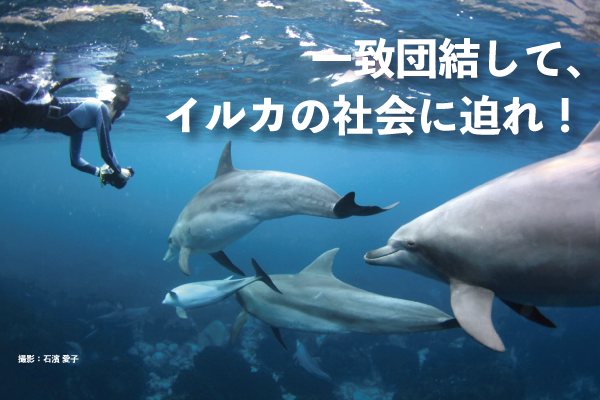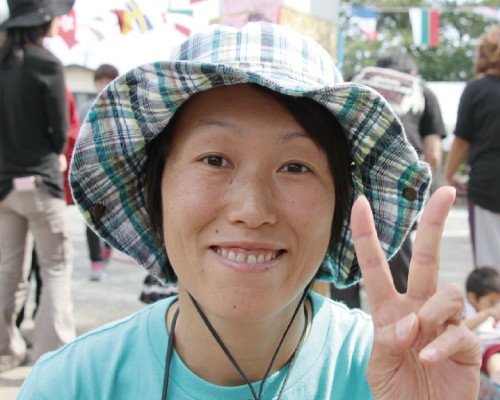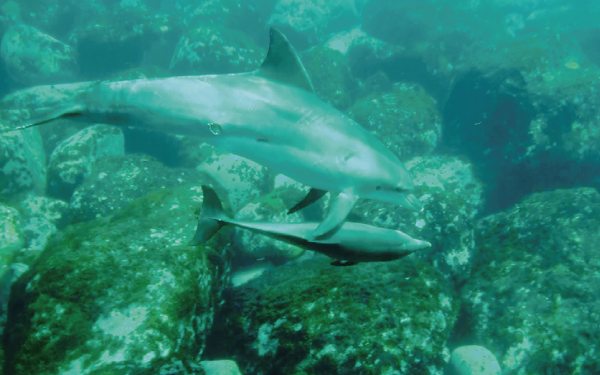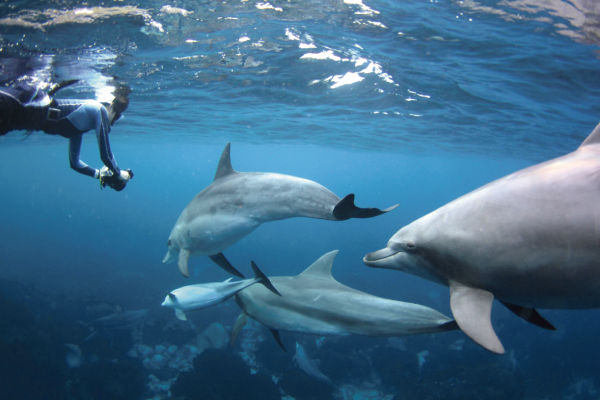- someone
- Information for Middle and High School Researchers
Unite and close in on the dolphin society!
2021.07.07
Let's go meet the researchers.

Mai Sakai three
Lecturer, Department of Fisheries, Faculty of Agriculture, Kinki University
Mai Sakai of Kinki University was fascinated by dolphins at an aquarium when she was a child and was looking for a job that would allow her to work with them. When she entered high school, she learned that researchers existed and was surprised to find that biology, which she had thought was a subject to be memorized, was a discipline full of unknowns in the world of research. I would love to work with dolphins and learn about things I didn't know," she said. Sakai has fulfilled that dream and has been active as a researcher of dolphin sociality for more than 20 years.
Sanctuary for wild dolphins in Tokyo
Mikura Island in the Izu Islands(magic) spellApproximately 140 wild southern bottlenose dolphins live around the island. Since 1994, identification surveys have been conducted to determine the sex and age of many of the dolphins, as well as their relationship to their mothers and offspring. Such an environment is very rare in the field of dolphin research in the world. Mr. Sakai has been visiting Mikurashima Island, which can be considered a sacred place, since 2000.
World's first discovery of foster behavior in the wild!
In 2012, Sakai received word that a mother dolphin named Ringo-chan had become entangled in a fish net and died. The island's guides, tourists, and Sakai were all worried about the whereabouts of the remaining dolphin. Two weeks later, one of the guides reported that a young female named "Hoppe-chan" was carrying a child she was not supposed to have given birth to. We tried to match the characteristics of Ringo-chan's child with those of Hoppe-chan's child from photographs taken by the guide and found that they were the same animal. Furthermore, although Hoppe-chan was 8 years old at the time and had not yet bred, we also observed the care behaviors that occur between a mother and her offspring, such as breastfeeding. This was the first time in the world that so-called "foster parental behavior," in which an individual who is not the biological parent raises an orphan, was observed in a wild dolphin.
I wonder if there is any benefit to the Hopetes in taking care of orphans." For example, if the birth parents and foster parents are related, it would lead to the preservation of one's own genes. Also, if the two animals have a close relationship, there is a possibility of helping one of the children. Therefore, Ms. Sakai analyzed the kinship between Ringo-chan and Hoppe-chan and their past social behaviors. The results showed that, interestingly, the girls were not close relatives and no affinity relationship was found between them.


Results not revealed by researchers alone
In response to this foster parent behavior, Sakai said, "Considering the complex society of dolphins, it is not surprising that such altruistic behavior occurs in addition to behavior directly related to the survival and reproduction of the individual dolphins themselves. I was more impressed by the fact that this case was revealed not only through research by researchers, but also through the cooperation of guides and tourists," he says. For example, many of the photographs of orphans that were needed for identification were provided by guides and tourists. In addition, the fact that Hoppe-chan had never bred before was made possible by the many years of data accumulated on individuals through individual identification surveys. This world-first discovery was the result of the concerted efforts of all the people who had been watching over the dolphins on Mikurashima.
Let's take a look at the dolphins' society
Dr. Sakai says he is fascinated by the elusive complexity of dolphin society. Although the complexity of dolphin society makes it a difficult field to study, Sakai says that the methods for studying the social behavior of living creatures are very simple and require only your eyes and a writing utensil. Even if you are not a researcher, you can notice something by continuing to observe, as in the case of the foster parents' behavior in this case. It's a bit of a waste to have visitors to an aquarium stop for a moment in front of an aquarium tank and then move on," Sakai said. According to Sakai, if you spend 15 minutes looking at the fish, you will be able to distinguish individual fish, touch other fish with their pectoral fins, and notice various behaviors, such as bubbling. When you visit an aquarium, why not take the time to stop and observe the dolphins? You may encounter a world-first discovery that even researchers don't know about.
(Text: Rikiya Takahashi)
Profile of Mai Sakai
D. in 2006 from the Graduate School of Bioscience and Biotechnology, Tokyo Institute of Technology. After working as a JSPS Research Fellow at the Wildlife Research Center, Kyoto University, and the Research Organization for Creative Science and Technology, Tokai University, he has been in his current position since 2015. He has been studying cetacean society, behavior, and cognition in both wild and captive environments. Currently, I am focusing on the rearing period of cetacean dolphins and studying how the mother's caretaking behavior affects the lives of her dolphin calf.
